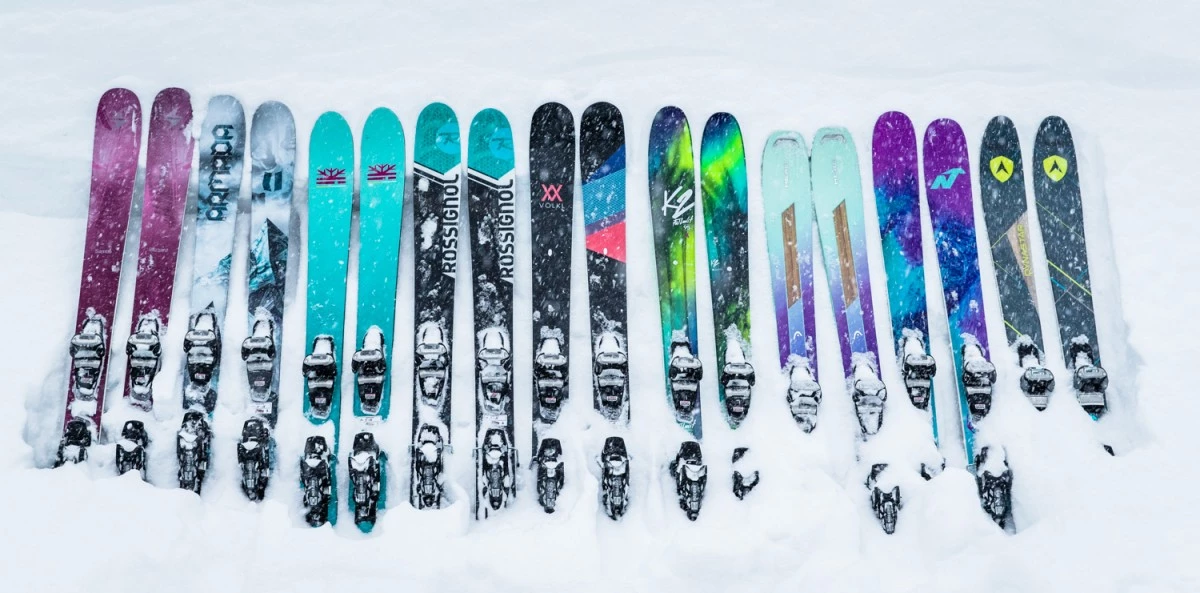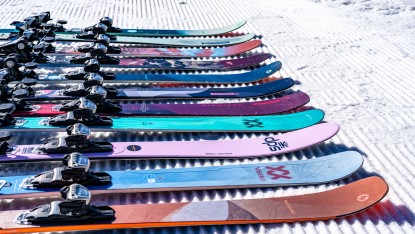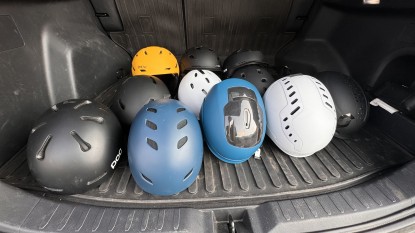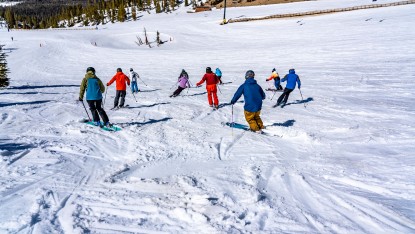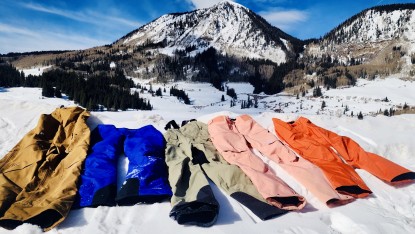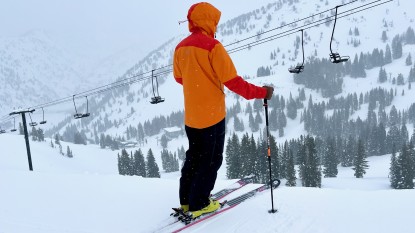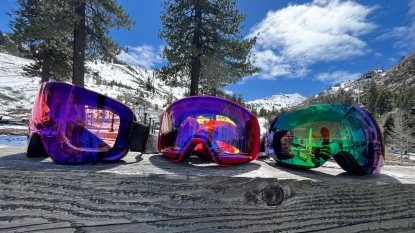all mountain women's skis are meant to do exactly what their name suggests - ski in various conditions across the whole mountain. These skis provide a consistent ride throughout various terrain, snow conditions, and speeds - from steeps to mellow pitches, from groomers to powder, and from terminal velocity to a snail's pace.
The all-mountain models we tested belong inside the ski resort. They have been specifically designed with lift-riding in mind, rather than hiking or skinning to earn your turns, like a lighter-weight backcountry skiing model might be. Yet, this should not preclude these skis from performing well in the types of snow and terrain you might find in the backcountry; they should be able to move with ease between groomed and ungroomed snow.
Choosing a single ski that will be perfect for you may seem daunting, especially because everyone skis differently, for different reasons, and in different places and conditions. Fear not - our review helps guide you to the perfect planks and demystifies the selection process for those who want that one perfect ski to take them everywhere.
What Style Should You Choose?
Deciding which ski you will spend all your time on can be intimidating, but we're here to help. First, you must consider which type of terrain you spend the most time in. If you love groomed runs and don't venture off often, choose an on-piste or front-side model, something better at carving and holding an edge on harder snow. These are often slightly skinnier underfoot and have a shorter turn radius. On the other hand, if you know that you save your ski days for when mother nature has left a foot of snow on the mountain, then you should opt for a more powder-specific ski that will keep you floating in the deep snow.
However, if you are a die-hard skier and want to be out in all conditions, you want the best of both worlds — all-mountain ski will provide you with this compromise. Even if you've already narrowed your choices to all-mountain resort skis, selecting from that point can still be overwhelming as there are so many options.
All-Mountain Skis
Within the women's all-mountain ski category, designs vary dramatically, and each style often still has a preferred terrain. Some feel more suited for groomed runs, yet have enough width and rocker to succeed with style on a storm day. Other models have fat waists and less sidecut for those gals who love to rip off-piste and want something they will feel stable on when riding the groomer back to the chairlift. Skis like these are possibilities for your “quiver-of-one.” Mastering all types of snow and terrain, to some extent, they are the perfect option for anyone who only has the budget or the storage space for a single pair of planks.
A word borrowed from archery, a typical ski quiver consists of a pair of early-season rock skis that can get beat up, an all-mountain pair (or several that have different specialties), and powder boards. To round out your choices, throw in a backcountry skiing pair.
If you're only choosing one pair of skis to do everything, then you want a pair of all-mountain skis. If you want two to four pairs, you're still likely to have an all-mountain set in that bunch. All of our testers, who each ski between fifty and two hundred days per season, have an all-mountain ski in their back pocket for days when conditions might be uncertain, and they don't want to commit to either skinny or fat.
Other Styles of Skis
While this particular review is for all-mountain skis, there is a huge range of other varieties of sliding sticks out there. We'll give an abbreviated outline of the different designs to understand better how the all-mountain model fits into the grand scheme.
On-Piste/Carving
These skis are a step down in width and a step up in sidecut from the all-mountain category. Sometimes referred to as front-side boards, these models are meant for women who intend to stay on the groomed runs all day and may want to play around carving tight turns around some bamboo — but have no interest in skiing the rough stuff.
Racing
Racing models are much skinnier, more expensive, and designed for particular purposes. If you want to go fast in icy conditions and are interested in getting on the Super G or Giant Slalom courses, do some research and get yourself a pair of racing planks.
Big Mountain
Many experts reach for a big mountain model when they're going for a big day out. These are longer and stiffer and with lots of camber. They can plow through any type of snow conditions. Getting dropped off by a heli at the top of a mountain in Alaska to rip some spines? Get a big mountain pair.
Powder
This category has changed a lot in the last ten years. You will find these models with ever-increasing waist dimensions and rocker. They have at least a 100-millimeter waist with a very short effective edge and lots of rocker. They don't perform the best on-piste and will often feel awkward on groomed runs because so little of the edges touch the snow. If you are looking for a great addition to your lineup and anticipate a lot of pow-shredding, powder planks sure are fun in their element.
Park
Depending on the manufacturer, these can also be called freestyle or jib skis. Park skis are a bit skinnier in the waist and usually center-mounted for riding switch in the terrain park. Typically they are twin-tipped and have a softer flex for softer landings. If you prefer hucking your meat off of jumps and rails all day, a park model may be for you.
Backcountry
For skiing outside of the resort, backcountry models come in various shapes and sizes, but weight is one of the main concerns. If you are going to be hiking in the backcountry, you want a lightweight setup. They often have a lightweight core and are paired with a binding that allows the heel to be free for the climb up. Backcountry-specific models often compromise the downhill performance slightly in favor of lighter weight, so we do not recommend them for resort skiing. Check out our and Backcountry Ski Review for information about which ones perform best outside the resort boundary.
Cross-Country
Unlike downhill skis, cross-country skis are mostly for flat travel, like the groomed trails at your local Nordic center. These models often do not have metal edges and are much skinnier and lighter than any alpine model. These skis have minimal bindings that allow your heel to lift as you stride or skate along.
Why Choose a Women's Model?
Women's models are often shorter, with a softer flex, because women are typically shorter with less weight to throw around. A specific design makes them easier for many ladies to operate - particularly beginner, intermediate, or laid-back skiers. Many expert women skiers buy unisex or men's skis because softer, more flexible skis aren't stiff or stable enough to keep up with them on the mountain. Lately, manufacturers are making an effort to lighten up their women's skis to suit smaller bodies while maintaining stiffness. Added carbon in many models helps increase stiffness while reducing overall weight.
Women's specific models are often only available in shorter lengths – up to about 175 or 180 centimeters or shorter – which can be a bummer for taller women. We were surprised to find that we were on the longest length available of some of the models we tested. Shorter models are easier to turn and control but typically perform poorly at higher speeds or in deep snow.
Take it or leave it, women's specific models exist, and for most female recreational skiers, the women's versions are an excellent choice to get you sliding on the snow. You may want to choose a unisex model if you are larger, stronger, or more aggressive than the average lady.
Flex
When a ski has a very stiff flex, it requires a lot of power and weight to bend the ski and make it grip the snow. Women are typically lighter than men, so manufacturers usually make women's versions in softer flexes than the male equivalent. With comparatively less weight behind our power, women may benefit from a slightly softer product that they can throw their weight onto and rail into turns. Still, this is somewhat contentious among ladies with advanced skills because they can bend and turn stiffer models just like the guys. Again, if you are a high-end skier or are more comparable in size and weight to most of your guy friends, you may want to select a ski that we've determined is on the stiffer side.
Recommended Mounting Point
Women have more posterior weight in their athletic stances, meaning that our center of gravity is lower around our hips. Men tend to carry more of theirs in their upper torso. Some manufacturers account for this by moving their recommended mounting points closer to the middle (lengthwise) for women to bring the posterior weight forward for better control.
Graphics
We know that graphics and colors can be very personal, but we don't mind having more graphics options. Most manufacturers change top sheet graphics every year or two even if the other ski specifications remain the same.
Things to Consider When Choosing Your Skis
First, think about your skiing style, ability, and terrain preference. Do you like to cruise groomers, or do you want to hit the steep off-piste runs? Do you like tight, snappy turns, or big, flowy arcs? Keep this in mind as you read.
Skill Level
You will need to assess your skill level realistically before choosing your ski. If you get one that is too advanced for you, the fun factor will go right out the window. If you get one that is too beginner, you will get bored and won't feel supported to access the terrain you want.
Beginner/Intermediate
Are you still working on your wedge to parallel (pizza to french fry) transition? Do you stick mostly to green circles and work on blue squares? It would be best to look for models with a softer flex, a skinnier waist, and on the short side in length. A ski with some rocker might help make turns easier.
Intermediate/Advanced
Are you working on getting down those black diamond runs and starting to venture off-piste and into the powder? Maybe you're gaining confidence at speed on groomed or steeper runs. Consider a model with a bit more waist width, medium stiffness, and longer. A rockered model will help you get more float and stability in the crud.
Advanced/Expert
Advanced and expert skiers cruise with confidence everywhere you can see on the resort. You like to charge big lines and cover ground at higher speeds. You are comfortable on bumps, crud, powder, and on-piste. You want a stiff ski that is stable at speeds and holds an edge. You may be building your ski collection and have a skinnier-waisted carving model and a fat powder pair.
Length
What length to choose is a complicated question, with no clear answer. Consider your ability and the speeds you prefer. The more competent you are, and the faster you like to go, generally, the longer a ski you want — to a point. A good rule of thumb for length is when you stand the ski with the tail on the ground, it should reach anywhere between your chin to the top of your head. If you are a beginner or intermediate skier, go for around the chin height, as shorter models are easier to turn.
If you are an expert skier, you may want a ski that reaches the top of your head or even over your head. The complicating factor with most modern designs, especially in the all-mountain category, is that they often come with a lot of rocker in the tip. Extra rocker means less effective edge touching the snow, so they feel shorter. If the model you are purchasing has rocker (as all the skis in our current review do), you may want to bump up a length from what you typically would buy.
Rocker Profile
If you look at your ski from the side in profile, does it look like a smiley face or a funky mustache? Rocker, or reverse camber, is how much the tip and tail raise off the snow when it sits on the ground, un-weighted.
Camber is used generously in carving-specific models and gives power in the turns and edge hold. The amount of camber is obvious when the ski is on the ground un-weighted. The point where the camber touches the snow or ground is the length of its effective edge.
Four profiles are most common:
Full Camber
Historically, most skis were full camber. They have a large arch underfoot where the ski does not touch the snow until very close to the tip and tail. Most carving and racing models are still fully cambered for great edge hold and stability at speed.
Full Rocker
Full rocker is the reverse of camber and creates a slight U shape from tip to tail. Fully rockered models typically float well in powder because their exaggerated tip and tail lift allows you to stay on top of the snow with greater ease. Fully rockered models are also easy to maneuver because they have a minimal effective edge, so they turn on a dime. You will find fully rockered skis in the park, all-mountain, and certainly in the powder.
Rocker/Camber
This design incorporates rocker in the tip but still has camber underfoot. The advantage of tip rocker is that it makes it more versatile. It has more float, a shorter effective edge, and is easier to turn, but still has camber underfoot for added power and stability in turns when at higher speeds. These skis have no rocker in the tail, which is fine unless you're landing switch off cliff drops into powder (which we aren't).
Rocker/Camber/Rocker
This profile is becoming the standard and defines all of the all-mountain models we tested. It is just as it sounds: rocker in the tip, camber underfoot, and rocker in the tail. This profile gives the ski added playfulness and float and still has the benefits of camber underfoot. The tail rocker allows you to land cliff drops switch in powder (if that's your thing) and seems to add some silkiness to the back of the ski, allowing you to smear turns in the fresh stuff easily.
It's hard to wrap your mind around initially, but the Elan Ripstick 94 W has dedicated left and right skis. The inside edge (the one you're pressuring and relying on for edge hold) has regular camber for grip and stability. The outside edge has more rocker from the tip and tail to provide a smoother transition and forgiveness.
Unfortunately, there is no industry standard for measuring or qualifying how much rocker a ski has. Some manufacturers will give a percentage of rocker versus camber such as 30 percent tip and tail rocker and 70 percent camber, but we find these numbers quite subjective.
Shape
Depending on your needs on the slopes, the shape can play an important factor in your ski performance. Waist width, sidecut, and turn radius all help determine the behavior of your ski and can either complement or combat your style.
Sidecut
Sidecut is the overall shape of your ski. The waist dimensions relative to the tip and tail will determine the sidecut. The more sidecut, or the larger the difference in waist versus tip or tail measurements, the easier the ski will turn and carve. One way to visualize a ski's sidecut is if you laid it on the snow on its edge, how much light would come through the space near the binding? A large gap signifies a large sidecut; a smaller air space denotes less sidecut.
When a ski has a lot of sidecut, once you get the ski on edge, the rest of the work is done for you. With less sidecut, the ski needs to be driven a bit more and prefers broader turns — this is easier for more advanced skiers.
Turn Radius
Turn radius represents the natural turn shape and size of a ski - if it were possible for it to turn independently. The shape and sidecut of a ski determine its turn radius. Typically, the larger the sidecut, the shorter the turn radius is, but the ski's stiffness also plays a role in the designated radius.
If you like tight, peppy turns, choose a model with a small turn radius. If you like big, flowy turns, then select a larger one. You will be much happier if you determine the turn radius and try to make turns that work with those parameters. Have a read of our ski reviews within the carving sections to learn whether the ski's advertised radius matched how tightly we felt it wanted to turn.
Waist width
Waist width is simple: it is how wide the ski is right underneath your foot. The wider the waist, the more float you will often have in powder; the skinnier, the easier and quicker the ski will tend to turn and change edges. The all-mountain models in this review have waist widths ranging from 88mm up to 106mm. On-piste carving models typically have a skinnier waist width of 85mm or less, and powder versions usually start at 110mm or greater.
Ski Construction
You might need to become familiar with the different construction types and materials to decide the best balance of quality versus budget. Here we outline the typical construction types and components of a ski. As you may imagine, there are many types of materials out there and varying opinions about each one. We are just providing an overview.
Core
The core is the ski's meat and potatoes and what gives it its flex and character. We have seen some fads in core construction in the past, but wood is the classic and most reliable material. Wood is the preferred core material because of its damping properties and rebound but is usually the most expensive. All of the products we tested have wood cores of one variety or another. Typically other core materials are foam or a foam and wood combo. Foam is less expensive and lighter weight but doesn't give as much rebound.
Composite Layers
These are all the other materials that sandwich below and on top of the core. They can consist of anything from fiberglass and epoxy to carbon. These layers add to the ski's stiffness and hold everything together. An increasing number of on-hill skis use carbon fiber for increased rigidity and torsional tension.
Base
The base is exactly that — the bottom of the ski. Bases need to slide well on snow, but they also take a beating from running over rocks and ice. Manufacturers use ultra-high-molecular-weight polyethylene (UHMW-PE) for base materials, and bases are usually only about 1.5mm thick. There are two ways of creating the base — sintered and extruded. High-end models typically use sintered bases: It is harder and accepts wax better. An extruded base is just the opposite. It is challenging to determine the type of ski base unless you contact the manufacturer directly and ask.
Sidewalls
The edges of your skies will have a sidewall or a cap. Sidewall or “sandwich” construction uses an extra piece of plastic that runs the length of your ski from tip to tail. It connects along the edge with the top sheet and the base and edge on the bottom. Cap construction wraps the top sheet over the top edge, wrapping over the sides and meeting up with the bottom edge like it's wearing a cap.
Sidewall construction seems to be the preferred method in high-end models, and most people believe it is a higher-performing construction because the edges have a better hold. The softer piece of plastic seems to have dampening qualities.
We have noticed during testing that sidewall construction does seem more durable than a cap. The cap models in our review seem to get more chips in their top sheet. It is quite common to see a hybrid cap/sandwich construction these days. This construction has the sidewall underfoot for performance but is capped at the tip and tail to reduce weight and cost.
Top Sheet Graphics
These initially draw us to the ski — and proudly display the manufacturer's graphics. The top sheet is usually made of plastic and is the waterproof layer that protects the ski.
Glossary of Terms
Like the Inuit people of the north, skiers have many words to describe snow. We also use colloquialisms to describe other elements of the sport, including style and technique. Below we attempt to illustrate some of this mystifying taxonomy.
Piste: Originally a French term, now adopted worldwide, to describe a marked trail with an artificially groomed surface of packed snow. Off-piste is any route on the mountain that is not on-piste and can consist of all types of snow (see snow terms below).
Snow Terms
Chop/Crud: Any type of snow that has been chopped up or pushed around. This condition typically occurs after a powder day but could occur on skied-out groomed runs on a spring day. Crud is usually heavier, denser, and warmer than chop, but some might interchangeably use the same terminology. Chop is still fun, but it requires a lot of work and often wears people out.
Cold Smoke/Blower: Residents of the Rockies and Interior British Columbia are familiar with this type of powder snow, although it occurs anywhere there is a very cold snowstorm. This snow condition is the holy grail of powder: light and fluffy. Extremely easy to ski and sometimes described as bottomless (unless you're hitting the icy bumps underneath), you may see snorkels in use on a cold smoke day.
Bullet-Proof/Hardpack: Bullet-proof can mean extremely hard, icy conditions – be prepared with sharp edges. Hardpack may be slightly softer than bullet-proof and typically skied or side-slipped. These conditions are often a result of melt/freeze situations or low snow years. You can sometimes avoid this condition by choosing the right aspect; don't ski a still shady pitch the morning following a warm day.
Slush/Elephant Snot: You can find slush on warm days in the spring, especially at lower elevations. Slush can be fun because you can smear on it. Elephant snot is a step down on the fun-o-meter from slush — the kind of snow you find transitioning from shade to sun.
Chalky: Imagine skiing on a huge block of compacted chalk. You can find chalky snow in shaded, off-piste areas, and it is almost always firm, consistent, and fun.
Wind Buff: A phenomenon oft-experienced at Mammoth Mountain, which can make for surprise almost-powder days. High winds will deposit it in pockets around the mountain when snow is available for transport. If you are lucky enough to find one of these deposits, it is a lot of fun.
Death Cookies: When there has been a lot of melt-freeze going on, death cookies - or large chunks of ice - will form. Sometimes these are also created by a groomer plowing over something icy. You will know you have hit a patch of death cookies when it feels like you are skiing over rocks.
Sastrugi: A Russian word that describes the sharp and consistent ridges of ice and snow usually caused by strong winds. Sastrugi tends to look like the snowy version of sand ripples just underneath the surface of waves in the ocean — except instead of the waves coming down to smash you, the sastrugi reaches up to grab your skis, and then you smash yourself.
Skiing Terms
Chatter: When you are trying to rail a turn, and your boards act like your teeth in the cold, chattering under your feet. When this happens, it usually means you're asking the ski to do something it does not want to do.
Schralp: Shralp is a verb and means to “rip,” "shred," or “tear” something up, like the slopes. We use this to describe skied-out snow after a powder day: “Man, the mountain is totally schralped.” You can also schralp a sick line.
Schnoodle: Although Urban Dictionary says otherwise, to Schnoodle, or schnoodling, is a verb meaning to turn like you are on a monoski. This skiing style involves keeping your knees close together while wiggling your bum. A onesie is a preferred outfit to Schnoodle in.
Schuss: Technically, a German word meaning straight-line downhill on skis, but we just use it for skiing, as in, "Do you want to go for a schuss today?"
Steeze: When you perform a trick in the park with style and ease, it is “steezy.” You can also use it to describe stylish clothing.
Conclusion
We hope that this guide helps you understand the differences between the various ski shapes, sizes, and materials and what to look for to narrow in on the best type of skis for your skiing style, terrain, and budget.

